Henry Bowyer Lane
| Henry Bowyer Joseph Lane | |
|---|---|
| Born |
1817 Corfu, Greece |
| Died |
1878 Birchfield, Birmingham, England |
| Nationality | English |
| Alma mater | Blundell's School |
| Occupation | Architect |
| Buildings |
Osgoode Hall Toronto's second City Hall |
Henry Bowyer Joseph Lane (1817–1878) was an English architect who worked in Toronto from c. 1841 to 1847.
Lane was born to Henry Bower Lane, a Royal Artillery Captain and Elizabeth Lacey in 1817 and moved to Devon, England after 1819.[1]
Lane's education included time at Blundell's School in Tiverton and subsequent professional training in England before he emigrated to Canada in 1841, living first in Cobourg, Upper Canada, and then in Toronto.
One of Lane's most significant contributions is Osgoode Hall, namely the west and central wings from 1844-1846. He designed and oversaw the construction of the incorporated city of Toronto's second city hall in 1844.[2] Lane's limited commissions outside of Toronto, in Niagara-on-the-Lake and Cobourg, were never as grand as his work in Toronto.
During his time in Toronto, Lane married Lucy Anne Sharpe in 1844, and they left the city in 1847. He is believed to have died in Birmingham, England in 1878.[3]
Works
| Building | Year Completed | Location | Notes | Image |
|---|---|---|---|---|
| Diocesan Theological Institute/Haskell House | 1842 | 174 Green Street and Queen Street, Cobourg, Ontario | College of Theology for Alexander Bethune, Anglican Bishop of Toronto [4] | 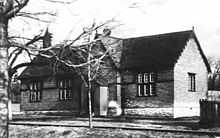 |
| St. Peter's Church original facade and tower | 1844; demolished after 1854 | 240 College Street, Cobourg, Ontario | 1st church 1844-1854[5] | |
| Brock's Monument | 1843 | Queenston Heights, Niagara Falls, Ontario | Plans to rebuild with a submission or proposal that did not win [6] | |
| Little Trinity Anglican Church | 1843 | 425 King Street East, Corktown, Toronto | Gothic Revival church with polychromatic brickwork. | 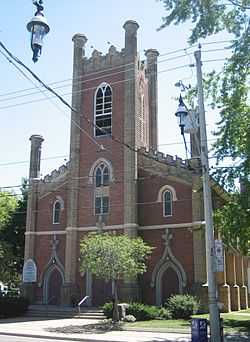 |
| Church of St. George the Martyr | 1845 | 197 John Street, Toronto | Gothic Revival church. Remnants survived a 1955 fire. | |
| City Hall and New Market | 1845 | Front Street at Market Street, Toronto | Toronto's second city hall, incorporated into St. Lawrence Market South in 1899. |  |
| St. Mark’s Church, Niagara-on-the-Lake | 1845 | 41 Byron Street, Niagara-on-the-Lake, Ontario | Ecclesiastical furnishings only[7] | |
| St Paul’s Church Anglican, Kingston | 1846 | 137 Queen Street, Kingston | Plans only[8] | |
| Osgoode Hall | 1846 | Toronto | Central and west wings | 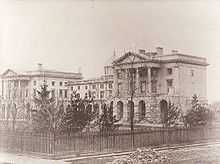 |
| Church of the Holy Trinity | 1847 | Trinity Square, Toronto | Gothic Revival | 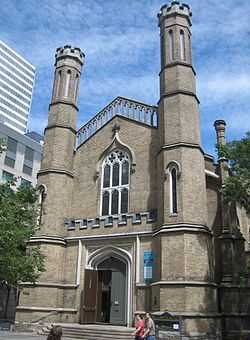 |
| Enoch Turner School | 1848 | 106 Trinity Street, Toronto | Gothic Revival school house is believed to have been designed by Lane,[9] who had left Toronto in 1847 | 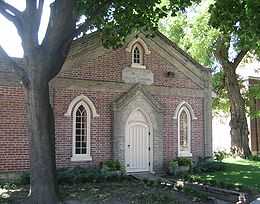 |
References
- ↑ http://www.biographi.ca/009004-119.01-e.php?id_nbr=4017
- ↑ Pound, Richard W. (2005). 'Fitzhenry and Whiteside Book of Canadian Facts and Dates'. Fitzhenry and Whiteside.
- ↑ http://www.biographi.ca/009004-119.01-e.php?id_nbr=4017
- ↑ http://www.cobourghistory.ca/walk.htm#north
- ↑ http://www.cobourghistory.ca/walk.htm#north
- ↑ http://biographi.ca/009004-119.01-e.php?&id_nbr=4017
- ↑ http://biographi.ca/009004-119.01-e.php?&id_nbr=4017
- ↑ http://biographi.ca/009004-119.01-e.php?&id_nbr=4017
- ↑ http://www.enochturnerschoolhouse.ca/index.php?option=com_content&view=article&id=49&Itemid=29&showall=1